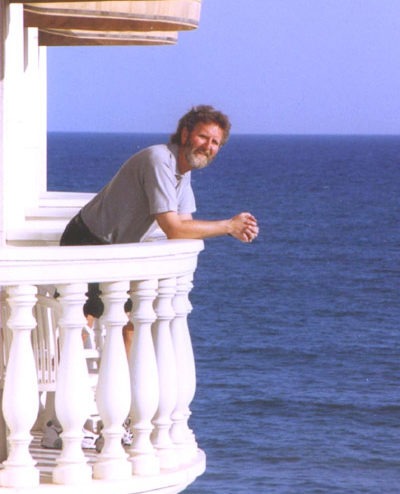
Mr. Write
Written by Rebecca Richards | Posted by: Anonymous
The focus on screenwriting as a popular form of creative expression is a relatively new one in our culture. While screenplays have always been an essential part of moviemaking, it wasn’t until the late 20th century that screenwriting came to be recognized as a form of artistic self-expression in its own right. And while most filmgoers for decades had been happy to just sit back and watch the story unfold on the screen, that all started to change in the 1970’s and 1980’s, according to screenwriting expert Michael Hauge.
"People have always had a need to express themselves," he says. "First in letters, then the novel, and eventually movies, which is where we’re at now. Don’t forget that in the 1950’s and 60’s people grew up watching TV and going to the movies. Storytelling on the screen became an ingrained part of our culture. So it seems only natural that people started thinking this was something they could do — this was a way they could express themselves, in the form of writing and making movies."
This burgeoning interest in screenwriting coincided with the success of such non-mainstream films as "Easy Rider" and "Nashville" and a shifting away from Hollywood movies as the only focus of the film industry. It no longer seemed like writing for the movies was something just for Hollywood insiders.
"You now saw film programs starting to pop up at colleges and universities all around the country. People started thinking, ‘Hey, maybe I don’t have to be in Hollywood to do this,’" Hauge says.
Learning how to write a screenplay and become a screenwriter became important areas to be explored. And while there have been books written on the subject of screenwriting as early as the 1930’s, there were no real guides on learning how to write for films until author Syd Field published his first book, "Screenplay" in 1982. "Syd’s was the first book that established some universal principles for story structure," says Hauge, "and the first to gain wide acceptance outside of college film classes."
The success of Field’s book opened up the door for what Hauge describes as the "second wave" of guides on screenwriting getting published. "People like Linda Seger, Carl Sautter, Viki King and me, " he says. "Where there used to be one or two books on screenwriting in a whole bookstore, our titles now took up half a shelf," he laughs. And while there have been literally dozens of how-to books written on screenwriting since that time, Hauge’s book, "Writing Screenplays That Sell," is now in its 25th printing and is considered by many to be among the best in its field.
"Writing Screenplays That Sell" owes its popularity not only to the expert advice that Hauge shares, but also to his genial and friendly tone, which is in evidence throughout the book. He presents the craft and techniques of learning to write a script in simple, direct language. It’s a comprehensive guide that can be used by both the novice screenwriter as well as the more experienced writer.
Hauge’s book and his teaching both began as a desire to share what he had learned from years as a development executive in Hollywood. "Development is really the generic term for the process of getting a story or screenplay greenlit," says Hauge. "In my case, that meant working closely with writers, having ideas pitched to me, and reading hundreds of screenplays."
He grew frustrated by the number of badly written scripts crossing his desk, and so he decided to start teaching writers ways of avoiding all the mistakes he was seeing. His first classes were at Sherwood Oaks College and UCLA, but he realized there was interest in the art form all over the country. So he began presenting his ideas throughout the U.S. and Canada in an unusual format: now-familiar weekend seminar. Hauge decided to write "Writing Screenplays That Sell" as a result of having students from his screenwriting seminars ask him to put his principles and methods into a book.
With screenwriting now receiving more attention and familiarity, there developed a belief among the public that anyone could write a screenplay. The trade press would print accounts of unknown writers getting paid six-figure sums for a script, and folks would wonder, "How hard can it be?" Soon thousands of bad scripts were floating around Hollywood.
"The truth is, anybody can write a script," says Hauge. "But not everybody can do it well. It’s a very difficult craft to master. It takes time, commitment, a steep learning curve and a thick skin for dealing with rejection." Not attributes that we all possess. Hauge also clarifies what he says is a misperception that screenwriters are regularly making millions of dollars for scripts they write. "While there is a small group of rarified writers making upwards of a million dollars per film, most working screenwriters don’t make anywhere near that," says Hauge.
While the big money stories make the news, Hauge says that in all his years of teaching to thousands of people all over the world, never once has anyone said they want to write screenplays just because there’s lots of money in it. "There’s something beyond that," he says. "It’s not about the big dollars. People really just want to get their stories told, see their vision realized, and touch millions of other people."
But Hauge says he actually wishes more writers would think about money and be aware they are actually writing for a marketplace. He says that too few screenwriters will actually acknowledge the large financial investment involved in turning their script into a film. "As you’re writing, Hauge says, "think about how your story will play at the local Cineplex. Will people actually line up and spend money to buy tickets? If not, what’s the point of writing a screenplay that will never reach an audience?"
Hauge readily acknowledges his bias towards mainstream Hollywood film. That’s his background, and those are the movies he knows and likes best. But he also acknowledges the success and influence of independent films, many of which are darker in subject matter and have more ambiguity to them than more mainstream fare.
"But successful independent films still abide by the same basic principles of structure and character that studio films do," he says. "They may push the envelope, but it’s not as if successful filmmakers in that world don’t understand the rules of storytelling." He cites writer/director Quentin Tarantino’s work as an example. "Just look at what he’s done," says Hauge, "He’s able to bend some of the rules because he knows the rules so well. And it’s not as if Reservoir Dogs or Pulp Fiction were complete aberrations. They just tweaked the formulas audiences had come to expect – just enough to make them exciting and compelling." Hauge emphasizes that all writers should learn the principles of effective storytelling before they go off the beaten path. "It’s fine if you choose to break a rule or escape the formula. The mistake is to ignore the rules and think you can do whatever you please."
Hauge says that all successful stories have three essential elements in common. The first one is the Hero — the person the story’s about. It’s important that the audience empathize with her (or him). She doesn’t necessarily need to be a likeable person, but the audience needs to relate to her. The second key element is Desire — is he or she desperately wanting something? And the third key element is Conflict — are there insurmountable obstacles standing between her and her desire?
Hauge says one of the most powerful tools he’s developed while coaching writers is to ask them a series of questions about their scripts. "I tell them they should ask themselves, ‘Is this really a movie? Or might the story actually be better told as a novel or play?’ " He continues the exercise with more thought-provoking questions to get the writer really thinking about the work: "What is the hero terrified of? How does he change and grow? How is this story reflective of me? How are the hero’s fears reflective of my own? Why will an average moviegoer in Minneapolis or Portland want to pay 10 bucks to see this? And why am I so passionate about this story?"
My job is to help them target what they’re trying to say with what they’ve done," he says. "I ask questions about how they see the story; how they see the characters. If all I do is provide criticism, I’m just expressing my vision of the story — not theirs."
While taking classes and reading books on the craft is important, Hauge also stresses that nothing is more important than the actual writing itself. "You must write every day — even if it’s only for 15 minutes on a lunch break. You’ll learn more from the process of writing — and rewriting — than any book or seminar can ever teach you." You must also study lots of successful (and sometimes unsuccessful) examples of what you’re trying to do, he adds. "You’ve got to see at least one movie, and read one screenplay of a produced film, each week. See everything that’s released in the genre you’re pursuing. And then see the good stuff again on video, to study the ways those writers and filmmakers mastered their craft, and elicited emotion in their audiences."
Last year, Hauge teamed up with Christopher Vogler, author of the influential text "The Hero’s Journey," to teach a daylong seminar called The Hero’s 2 Journeys. "It was the first time we had ever shared the stage in the U.S.," says Hauge, "and we decided to record the session, since — because we’re both so busy with our own lecturing and consulting — it would likely never happen again." Hauge wanted to make sure writers and filmmakers everywhere could hear them compare and contrast their individual approaches to plot structure, character arc, and theme. So the event was taped and filmed, and is now available as both a DVD and a CD.
"Chris and I have been friends for years, as we kept bumping into each other at writers’ conferences. We both have the deepest respect for each other, plus we love to make fun of each other in front of an audience. We discovered our coaching and teaching had both grown in the same direction. So we thought exploring our latest ideas would be interesting."
As Hauge describes it, the essence of story is that a hero takes two journeys in the course of a novel, play or film. The visible, or outer, journey is one of achievement. "This is the finish line that drives the plot — the thing the audience is rooting for the hero to do by the end of the movie." But underneath is an invisible journey from fear to courage. "This is the character arc," Hauge says. "This is the hero’s transformation from someone living an emotionally protected but unfulfilled existence, to someone who’ll put everything on the line — face their greatest emotional fears, in order to achieve their destiny.
"The fascinating thing is," Hauge adds, "these two journeys follow exactly the same structure. Whether you approach it through myth and archetype, as Chris does, or by exploring the psychological tug-of-war between the hero’s identity and essence, as I do, these principles are essential for giving characters real complexity and depth. The most successful movies intertwine both of these elements. Once you’ve mastered this ability, then you’ll have joined the upper echelons of all screenwriters and filmmakers."
To learn more about 'The Hero’s 2 Journeys' or Michael Hauge’s screenwriting seminars and coaching services, please visit his website at www.ScreenplayMastery.com









